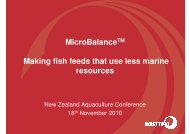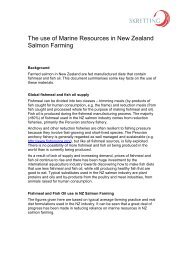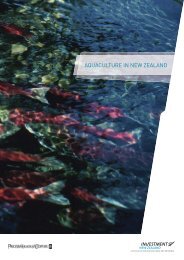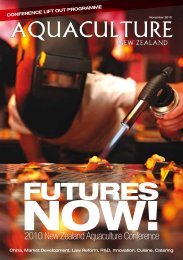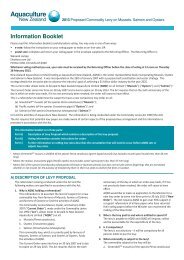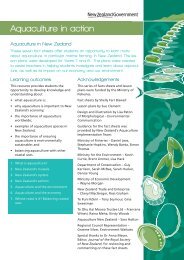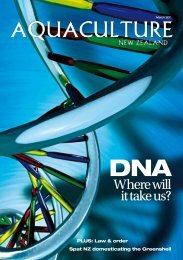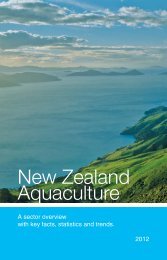May 2013 - Aquaculture New Zealand
May 2013 - Aquaculture New Zealand
May 2013 - Aquaculture New Zealand
You also want an ePaper? Increase the reach of your titles
YUMPU automatically turns print PDFs into web optimized ePapers that Google loves.
<strong>May</strong> <strong>2013</strong><strong>Aquaculture</strong>NEW ZEALANDThe innovatorPeter YealandsLearning the ropesQCCNext CropZane Charman
RecipeClarkey’sworldfamousmusselchowder4Chow down like achampion with thisoriginal recipe, from thekitchen of an originalmussel farmer.3 dozen live mussels1 pint of fluid from steaming mussels(volume really to taste)1 oz butter2 -3 tbs flour2 sticks diced celery1 pint milk1 large onion, sliced1 small can of whole sweet corn2 large potatoes, diced1 cup of Surprise dried peas1 bay leafMethod;Melt butter in large pot. Fry onionsand celery until soft. Add flourand cook. Stir in milk and otheringredients and bring to boil.Simmer approximately an hour untilthickened. Adjust thickness with wine(if any left in bottle).Optional: add cream before serving.Variations; add smoked fishand/or prawns.Chef’s note: The key ingredients arethe mussels, mussel juice, the Surprisepeas, and the potatoes. The rest canbe what’s available. Lots of pepperis good!Certification for NZKS<strong>New</strong> <strong>Zealand</strong> King Salmonhas achieved environmentalcertification for all farms andprocessing plants under theGlobal <strong>Aquaculture</strong> Alliance, Best<strong>Aquaculture</strong> Practices guide.The achievement gives thema two-star rating under theprogramme, and follows onfrom Mt Cook Alpine Salmon’scertification last year.NZKS Chief Executive GrantRosewarne said attaining thecertification confirmed their worldclassenvironmental standards.“We’re very pleased withthis certification. We can carrythe BAP certification mark onour packaging and that givesconsumers comfort knowing weare managing our activities inan environmentally sensitive andacceptable way,” he says.Spat retention researchIn response to the mussel industry’sclear signalling of spat retention asa priority research need, Cawthronhas submitted a research proposalfor the latest round of Ministryfor Business, Innovation andEmployment (MBIE) biologicalindustries funding.The proposed project buildson the Kaitaia spat qualityproject by identifying: optimalmethods and timing of collection,handling, storage, transportand seeding; environmentalparameters that enhance spatretention; and the degree thatspat quality at source influencessettlement and retention.Applications for the fundinground closed in early April,with decisions expected to beannounced in August.Oyster skippersprogrammeThe <strong>New</strong> <strong>Zealand</strong> Oyster IndustryAssociation is working to developtheir own oyster skippers trainingprogramme under the direction ofexperienced trainer Darcy Rangerof Coromandel.It follows moves from Maritime<strong>New</strong> <strong>Zealand</strong> to revamp skippers’training requirements and allow forsector specialisation.Mt Cook AlpineWork on Mt Cook Alpine Salmon’snew multimillion-dollar processingplant is set to begin this month.The new plant is part of thecompany’s ambitious, 5-year growthplans and will provide employmentfor up to 35 people. There is alsothe potential for a value-addedsmokehouse to be constructed inthe near future.Won’t be standingat AGMThe Salmon Farmers AssociationAGM on April 12 signalled theend of an era for the industry withMark Gillard announcing he willnot stand for re-election as theassociation’s Chair.Mark, one of the industry’smost respected experts and wellliked personalities, has led theassociation for the past 17 yearsand subsequently represented allsalmon farmers on the <strong>Aquaculture</strong><strong>New</strong> <strong>Zealand</strong> board since itsinception in 2006.Mark will continue working with<strong>New</strong> <strong>Zealand</strong> King Salmon but witha reduced work load following agruelling couple of years leading thecompany through the EPA process.Mark will remain at the helmof the SFA until a new Chair hasbeen elected.Trans-Tasman research<strong>Aquaculture</strong> <strong>New</strong> <strong>Zealand</strong> hasjoined forces with Australia’s FisheriesResearch and DevelopmentCorporation to develop an oystervirus challenge model.It’s the first ever trans-Tasmanresearch collaboration and madepossible by SFF funding for the OysterIndustry Modernisation project.As part of the project, leadingAustralian OsHV-1 researchers DrRichard Whittington and Dr IkaPaul-Pont from the University ofSydney, visited <strong>New</strong> <strong>Zealand</strong> in lateApril to gain a better understandingof how the <strong>New</strong> <strong>Zealand</strong> industry,Government and scientists managethe virus as well as to share theirown experiences.Bonds updateThe Northland Regional Councilhas agreed to work with industryto develop a proposal that couldavoid plans to impose hefty bondsand bank guarantee requirementson local oyster farmers.At their March 21 meeting, thecouncil accepted a <strong>New</strong> <strong>Zealand</strong>Oyster Industry Associationproposal to establish a new farmmanagement group that wouldguarantee and fund complianceof local farms.Councillors agreed for NRC staffto work with the NZOIA to developthe proposal further and report backto the council at its next meeting.While the decision does notmean the council has completelyabandoned the concept ofimposing a $9000/hectare bond orbank guarantee, it is a positive signfor the industry.The bond proposal could havepotentially crippled the industryby draining up to $3.27 million inborrowing equity.But under the plan presentedto the council by NZOIArepresentatives Ben Warren andTom Hollings, the industry will workclosely with the council, but willself-manage and fund complianceand clean-up of all farms that jointhe proposed Northland OysterFarm Management (NOFM).NOFM will ensure every membermeets the high standards set by theindustry, in accordance with theirEnvironmental Codes of Practice.We submit...<strong>Aquaculture</strong> <strong>New</strong> <strong>Zealand</strong> hasprovided technical advicesupporting industry on arange of policy reforms andmanagement strategies includingthe RMA Reform Bill 2012, theRMA Discussion Document <strong>2013</strong>,Maritime <strong>New</strong> <strong>Zealand</strong>’s newSeafarer Certification, and DoC’sConservation ManagementStrategies for Northland,Auckland and Waikato.To request a copy of thesubmissions please contactrebecca.clarkson@aquaculture.org.nzLatest SFF fundingMinister for Primary IndustriesNathan Guy has annouced fiveprojects focusing on aquaculturehave been approved forSustainable Farming Fund grants.The projects are:• Koura <strong>Aquaculture</strong>, by Wai-KouraSouth, SFF funding of $119,420• Farming Premium Salmon, by theSalmon Improvement Group, SFFfunding of $600,000• Management of the GLM9Greenlipped Mussel SpatResource, by GML9 AdvisoryGroup, SFF funding of $20,000• Tuna (eel) <strong>Aquaculture</strong>, by TeOhu Tiaki o Rangitane Te Ika aMauri Trust (MIO), SFF fundingof $600,000• <strong>Aquaculture</strong> custom bacterialvaccines, by <strong>Aquaculture</strong><strong>New</strong> <strong>Zealand</strong>, SFF fundingof $115,686“<strong>New</strong> <strong>Zealand</strong> seafood isa premium product and it isgood to see groups seeking toincrease production and value bydeveloping aquaculture.”“Addressing information gaps isa focus for four of these projects.They will investigate how to reduceskeletal deformities in farmedsalmon, learn more about young(glass) eels so we can raise themsuccessfully, develop best-practiceguides for raising freshwatercrayfish and manage the wildgreenlipped mussel spat resource.“The other will focus ondeveloping <strong>New</strong> <strong>Zealand</strong>’scapability, in this case tomanufacture vaccines forChinook salmon.” •Ah, shucks...Talley’s Motueka are officially the fastestmussel shuckers of <strong>2013</strong>, winningthe Havelock Mussel Festival musselopening competition.Talley’s won the final of the teams’event, a 4 person relay with eachopening 50 mussels, in a blisteringtime of 6mins39secs to edge out theKono1 team.In the individual race, Sanford’s ReyBernal took out the final opening his100 mussels in 2mins55secs, less thantwo seconds ahead of teammateKannha Keo.Shucks that’s fast…Individual final:Rey Bernal2.55.82Kannha Keo2.57.75Buck Fortes2.58.19David Auld2.59.57Billy Broughton3.09.81Josh Huntley3.16.90MAY <strong>2013</strong> 5
From early mussel pioneer toworld-leading sustainable wineproducer, Peter Yealands has earneda reputation as one of <strong>New</strong> <strong>Zealand</strong>’sgreatest entrepreneurial minds.More than 50-years on, it’s still thechallenge that drives...TheinnovatorPeter Yealands doesn’t subscribe And this is exactly what enticed him Peter was 20 years old and just“I did a hell of a lot of things peopleto the second mouse theory. to get involved with Greenshell mussels married when he put his first concreteprobably don’t know about, or thoseFor the one-time Greenshell when the industry was still in gestation raft in the water and soon becamethat did would have forgotten,” he said.mussel pioneer, business is not aboutwho gets the cheese – it’s about thechallenge of unlocking your goals.“I’d rather be the first to trysomething and get it wrong, than to besecond,” he says.And over the past 50 years he hascreated a career out of firsts.Occasionally it’s gone wrong. Thinkhawks attacking guinea pigs intendedfor weed control. But it’s gone rightenough times to earn him a reputationas one of <strong>New</strong> <strong>Zealand</strong>’s greatestentrepreneurial minds - and a regularspot on the NBR annual Rich List.It’s success that he credits to the‘let’s give it a crack’ attitude inherent inthe <strong>New</strong> <strong>Zealand</strong> psyche.“I’m a typical Kiwi,” said the65-year-old.“I’m no different to a lot of people.I’ve probably been a bit luckier which Iput down to my genes.“My whole life I’ve been drivenaround innovation and challenge.”in the late ‘60s.“I got interested on the day the firstMarine Farming Act came out... atthat time I was doing contract work forlocal authorities and I had a large taxbill,” he said.“I was discussing how I was goingto pay the bill with my accountantwho said, ‘look, it’s just a coincidence,but today I’ve received a booklet fromgovernment, about the introductionof the Marine Farming Act, and thegovernment are going to give taxsubsidies for those getting involvedin aquaculture.”“I said ‘that’s me’.”“In those days, there was no industrywhatsoever - nothing to go on. Nomussel ropes, or proven concept, nospat to speak of and it was all uphill.“But that was the appeal.“Whilst I hated paying tax, it was thechallenge of the unknown and havinga reason to try things and applyscience to it, that drew me in.”consumed by the new industry.“My new wife was pretty frustratedwhen I ended up spending everyweekend and night working on allaspects of the operation,” he said.“I was fully charged on this concept.I had other businesses, but was justdying to get into this, and after about6-8 months the enthusiasm boiledover onto the rest of the family andwe formed a company called <strong>New</strong><strong>Zealand</strong> Marine Culture Limited.”From trolling for spat with planktonnets, to helping establish the industry’sfirst hatchery, Peter had a hand inmany developments that helpedshaped today’s mussel farmingoperations, including several typesof anchors, mussel-specific ropeand stockings, buoys and the initialintroduction of Kaiatia spat.He even farmed scallops in lanterncages, developed a concept on seabedmanagement and created a fish baitdesigned to keep snapper away.When the Marine Farming Act wasreworked in 1975, Peter was one of thefirst to gain a marine farming licence.But after 20 years on the water, hedecided it was time to move on.“The industry had come a bloodylong way... I’d done my run,” he said.From there, Peter had stints in thedeer, forestry and farming industries.“I had lots of things going on... andfor a 15-year period I was supplyingaggregate to industries, so I had alot of machinery that led the way todevelop grapes.”Peter officially got interested in winein 1998 after planting his first grapeson a 70 acre property at Grove Town.“I was looking for a place to play,I bought a place that was derelictand cheap, but I knew I could makeit into a nice place and then I had awhole heap of left over land so I putin grapes because, what else was Igoing to do?” he said.“At the time, I’d never been on avineyard in my life. Sometimes the lessyou know the better.“That way you don’t have anypre conceived ideas.“I went onto that land not knowinganything about grapes or vines. I foundone good advisor and listened to him.“And when I got into wine, I’d neverbeen into a winery, until I decided tobuild a $25-million winery.”Today Peter is best known as thecreator, owner, operator and occasional‘mad scientist’ behind the celebratedYealands Estate which exports to 80countries and is one of the country’slargest independent wineries. Set over1500 hectares predominantly at Seddon,it’s Marlborough’s largest winery byarea and 5th largest by production andemploys over 140 fulltime staff and over500 in peak season.But when Peter started at theproperty, the land was considered toorugged for wine-producing land.In response, Peter pioneered‘vineyard terracing’ and developedhis own sites that now produce cropsof complexity and balance wherethe lush undergrowth in the gullies isbalanced by the lower yielding vinessubjected to harsher conditions thatproduce intense flavours.Today, the Yealands winery is valuedat closer to $45-million and celebratedas the world’s most sustainable.To complement the ‘green’philosophy of the business, Peter hasbuilt in a host of environmentallyfriendly systems including wet landareas on his farms to attract nativebirds and reduce erosion, making hisown fertilizer out of aquaculture, wineryand sawmill waste, and using miniaturesheep to control weeds.“Oh S**t yeah you can make moneyout of being sustainable,” he said.“All of the things I’ve got in placehave a very, very good pay back.“Our vine prunings used to be lefton the ground. Now we bundle themup and burn them to generate all ourhot water – that paid for itself in the first12 months. The alternative was to burnLPG forever and a day.”The sustainability element hasbrought Yealands plenty of localand international recognition andis widely incorporated into theirbranding and efforts to create aprovenance for their wine in premiummarkets around the globe.It’s a position Peter says theaquaculture industry is well placed tocapitalise on, given the similarities inlocation, sustainability and quality.“Mussels always need to sitalongside wine,” he said.“In terms of value, MarlboroughSauvignon Blanc gets a premium ofabout 200 per cent over any othercountry. It’s high value. It’s what peoplewant and is distinctively different.“Marlborough is no-doubt thehome of aquaculture and mussels, butbecause they are also grown in otherareas around the country, I don’t knowif a Marlborough mussel would havethe same impact as what wine wouldhave. But I think there is potential for itto get a lot better than what it is.”It’s been over 25 years since Peterput his last line in the water, but hereckons he hasn’t changed much.“I’ve been termed a maverick - Idon’t know why,” he said.“I just like to push everything. I liketo question. I like to think outside thesquare and find challenges of doingthings different and better.“Sometimes I wish I was not sodriven, I wish I could sit back and enjoythe spoils, but I’m still raring to go.”The spoils are not quite what you’dimagine - fish and chips on a Fridaynight is still his greatest extravagance.“I just liketo pusheverything.I like toquestion.“I don’t own a suit,” he said.“I live on the smell of an oily rag andI don’t own much more.“I’ve got a $5000 car and anaverage, to below average house. “While it might be clear that it’s notmoney that drives him – you’ve got towonder if just a small piece of cheesemight go well with all that wine. •6MAY <strong>2013</strong> 7
SingingthebluesJo O’Connell has the blues.Blue shell mussels that is - anddemand for them is growing.Jo, Omega Seafood MarketingManager, has been travelling thecountry promoting their vacuumpacked cooked <strong>New</strong> <strong>Zealand</strong> Blue shellMussels to the foodservice and highendretail sectors and says the responsehas been encouraging.“The reaction has been reallyenthusiastic, particularly from Europeanand Asian trained chefs who areexcited about being able to access aconsistent supply of blue mussels fordish authenticity,” Jo said.“Traditional Mediterranean disheslike paella centre around the bluemussels – and greens just look massivein their place. It’s the same with Frenchbouillabaisse or Irish mussel broth. A lotof Thai dishes are made for the blues.“They’re very sweet and very soft anda lot of people raised on them find thegreens are not sweet enough.”“I don’t think they will ever overtakethe greens, but it would be great ifpeople recognised they’re a deliciousshellfish, and there are ways to makemoney from them.”Although the Blue shell musselsthrive in <strong>New</strong> <strong>Zealand</strong> waters andnaturally attach themselves to the topof most mussel lines, farmers typicallyconsider them a pest.“Every day there are thousands ofblues being harvested and thrown overthe side because there’s no market forthem,” Jo said.“We’re sourcing ours from four smallerfarmers who harvest them by handfrom the top of crop lines and thendeclump them back at the factory toreduce breakages. There’s no specialequipment required - they are basicallya by-product of the harvest.”From there, the mussels are washed,scrubbed, partially de-bearded andthen cooked inside the packaging. A1kg pack contains 50-90 mussels witha shelf life up to one year. The musselscan be heated in the microwavein minutes and open without needof a knife (when the pack seal isbroken), making them perfect for thefoodservice industry.“We started with the blues after wegot a request from the United ArabEmirates for our Omega format,” Jo said.“We would struggle to be pricecompetitive if we tried to competewith live blues in our export marketswhere blues are grown locally, butour product form gives us a point ofdifference in this country.”Although she’s been working hard topromote the new product, they’re takinga soft launch approach into Australiaand <strong>New</strong> <strong>Zealand</strong>.“We showed them at Fine Foods inAuckland last year, and we’ve takenthem to high-end retail, including MooreWilson’s – but our emphasis has beenon foodservice and the take up hasbeen good,” she said.“Restaurants prefer to source livemussels, but struggle to get a consistentsupply of live blue mussels.“These reheat very well and give thechef all the presentation options of live,with limited wastage and other hiddencosts (like labour).”Jo might be singing the blues, butif this product fills a gap in the market,we all might be seeing blue beforetoo long.•Small,sweet,petiteSmaller is sweeter when it comes to selling GreenshellMussels in the <strong>New</strong> <strong>Zealand</strong> foodservice market.Greenshell <strong>New</strong> <strong>Zealand</strong>’s newIkana branded Petite mussels haveproved an instant hit with fine diningrestaurants around the country.The specially grown and harvestedsmaller mussels (65-80mm) weredeveloped in response to customerdemand and have been distributedthrough Yellow Brick Road since March.“We started getting calls for asmaller mussel and we’ve developeddedicated farming and harvestingtechniques to ensure supply,” saidGreenshell’s Commercial GeneralManager Mark Ventress.“We grade and clean them, removeshell adhesions and hand-pack so we’resupplying a premium product that’sready to use.“Greenshell mussels have becomeundervalued and in some cases donot suit the changing requirements ofrestaurants, but we’ve been surprised byhow enthusiastically the restaurant sectorhas taken to Petite mussels.“The response has been fantastic –we’re now supplying a significant numberof premium restaurants who were lookingfor something different.“The Ikana brand is all about addingvalue and doing things a little differently.“Everyone said you can’t do it becausemussels are a commodity.“But actually you can. It’s aboutadding value and what we found is thatour customers are willing to invest inpremium quality products if they meettheir needs.”Yellow Brick Road’s Rachel Taulelei saidthe Ikana Petite mussels had hit a sweetspot in the market.“There is demand for small greens andthere has been since I started working inthe industry,” Rachel said.“Greenshell mussels are beautiful, butas far as food service goes, the IkanaPetite mussels are slightly more palatable,presentable and portionable. If you’reserved 5 petites as opposed to 2 big youcould eat it in one shot, as opposed tocutting into halve and thirds.“A really nice plump Greenshellin a smaller mussel is a great product.”But until Greenshell <strong>New</strong> <strong>Zealand</strong>starting thinking petite, Rachel had troublefinding a supply model that worked.“I’ve tried in the past, and worked withpeople to commercialise the opportunity,but to this point it proved too challenging”she said.“I’m now really pleased and confidentthat I’ve found the right partner with IkanaGreenshell Mussels – they’ve cracked it.A beautiful product, packaged well, andwith a great story. I look forward to whatthe future holds for the Ikana Petites.” •Early indications are thesmall greens have hit asweet spot in the marketwith a very positivereaction to news of theirlaunch on social mediasite Facebook last month.Rachel “Am prettyexcited to see years(and years and years) ofbanging on about smallgreenshell mussels cometo fruition today!! Havepartnered with Ikana toplace petite greenshellmussels into a bushel ofour best restaurants. Themussels are small, sweet,plump, and perfect.Everything you want in agreenshell.”Catherine Cordwell YES,at last, well done!!Ruth Collingham Thesmall mussels werefabulous - had them inthe stunningly simpleseafood risotto at Capitolon Friday night. Keepthem coming please!!Karyn Murray Like likelike! The little ones are thesweetest!8april MAY <strong>2013</strong> 9
Almost thereIt cost $10 million and was over a year in the making but <strong>New</strong> <strong>Zealand</strong> King Salmon’sprivate plan change application to the EPA concluded last month with the finalapproval to build four new farms. Despite appeals from two environmental groups,the decision proved that salmon farming can operate in balance with the localenvironment and community.There’s an aura building aroundra King.The new brand, from <strong>New</strong><strong>Zealand</strong> King Salmon, targetingpremium food service markets hasbeen added to the menus of someof the world’s finest restaurants,including the Waldorf Astoria in <strong>New</strong>York, since its launch late last year.NZ King Salmon general managerof foodservice marketing JemmaMcCowan said ra King’s superiortexture and taste had been laudedby chefs world-wide.“ ra King has had a great initialreaction from some of the finestestablishments around the world.”Jemma says.“Feedback we’re getting suggestsprofessional chefs are delighted withthe quality of our King salmon anda dedicated food service brandbehind it enables them to add realvalue to their fine dining menus.”ra King has been releasedacross USA, Australia, Japan, Europeand China with a host of qualitychefs already adding ra Kingsalmon to their menus.Rather than a broad advertisingcampaign, Jemma said they’dused a word-of-mouth approachtargeting respected chefs to act asbrand ambassadors.“Unlike NZ King Salmon’s otherbrands, ra King is aimed solelyat professional chefs in qualityrestaurants.“Chefs are a particular breedand they’re not keen on taking aretail brand,” Jemma said.“Particularly at the fine-dining,premium end, chefs want anexclusive product designed forthem.”To make the ra grade, thefish pass through several qualitycontrol steps during harvest andprocessing and are generallyshipped in a chilled, whole-fishformat with a gill tag.“We have taken the specificationhigher and grading higher, tocream off the best of what we do,”Jemma said.“We think there is quite a demandfor it.“A chef is a professional, they havean eye for detail and know what theywant – they want the best. We needto deliver on that, so we’ve uppedthe game and tailored ra King todeliver what chefs want.”Part of the ra King strategy is thestrong brand story that starts withpure spring water in the hatcheryand is farmed sustainably andharvested humanely.“In export markets we’ve beenoperating generically as NZ KingSalmon prior to this, so there waspotential for confusion,” Jemma said.“This gives us the ability to tell ourstory and be clearer on who we are.“With that comesintegrated traceability andit takes us out of the typicalseafood commodity market.“We are stepping out of thetraditional market and turning itinto a product that has a name,can be traced, and gives the chefsconfidence of where it’s come fromand who’s delivered it to them. Andthat really resonates.“When a chef puts it on their menu,they put their reputation on the line bysharing our story with their diners.”But while there is growing demandin export markets, Jemma says a keypart of the strategy is to showcasethe brand in local restaurants.“<strong>New</strong> <strong>Zealand</strong> is the home of raKing salmon and delivering the bestof breed to our leading Kiwi chefsis a critical part of our strategy,”Jemma said.“We want our home market tobe a showcase of what we do.“We want ra King on themenus of the finest restaurantsin <strong>New</strong> <strong>Zealand</strong>.” •What it means:Grant Rosewarne, <strong>New</strong> <strong>Zealand</strong> King Salmon chief executiveThe EPA Board of Inquiry hearings are finished,the final decisions have been handed downand we have the green light to get on withbringing new prosperity to our region.Currently every year we create almost $25million in wages and salaries for the area. The EPA’sBoard of Inquiry has given us the green light forfour new farms covering only six surface hectares.That will enable us to double production to15,000 tonnes over the coming years bringingin to the country an extra $60 million a year inexport income and ultimately adding muchneedednew jobs to the region.We will also gather valuable scientificknowledge so the Marlborough Sounds canDr Nick Smith,Minister of Conservation“The Board has undertaken a thorough processbeing mindful of the need for <strong>New</strong> <strong>Zealand</strong>to conserve its natural resources with theneed to grow exports, jobs and wealth,”Dr Smith says.“These farms will occupy an area of just sixhectares of surface water space out of a totalof about 100,000 hectares in the MarlboroughSounds. They will enable King Salmon to growits production from 7,500 to 15,000 tonnes peryear, employ another 170 people and boost itsannual export earnings by an extra $60m.Peter Vitasovich, <strong>Aquaculture</strong> <strong>New</strong> <strong>Zealand</strong> chairman“This application sparked substantial debate inthe local community and provided everyone theopportunity to have a voice and to be heard,”Mr Vitasovich said.“The thorough and transparent processexamined all the concerns of environmentaladvocates including impacts on the seabed,water column, nutrient release, seabirds and seamammals as well as considering the naturallandscape of areas and navigation.“The Inquiry drew on independent scientificevidence and relevant experts and found<strong>New</strong> <strong>Zealand</strong> King Salmon can farm the fournew sites in balance with the local environmentand community.“We understand that the MarlboroughSounds are near and dear to the hearts ofbe better managed as a multiuse area. Atno cost to the ratepayer we will be fundinga comprehensive research programme ofnitrogen levels from all sources, not just fishfarms. That research will establish baseline levelsof nitrogen in the Sounds and their sources tosupport our contention that nitrogen levels fromfish farms have little effect on the environment.We have received great support from the Topof the South community. People understandthat commerce and conservation can worktogether. We look forward to getting on withthe task at hand and bringing our new farmson stream so we can support the economicwellbeing of the Top of the South.“This process has been thorough, fair androbust. The Board worked through more than1,200 public submissions, with more than 180witnesses and submitters heard and over10,400 pages of evidence received during a37-day hearing. Submitters have also had theopportunity to comment on the Board’s draftdecision released in December last year.“I particularly want to thank retiredEnvironment Court Judge Gordon Whitingand the Board for their work in carefullyconsidering and determining this application.”the community who work, fish, boat, dive andholiday on the water – and we agree wholeheartedly that there needs to be appropriatelevels of protection to ensure these activitiescan continue.“Salmon farmed in the Marlborough Soundsare desired in premium markets with NZKSwinning recognition from international chefsand culinary associations for producing some ofthe world’s finest salmon. The company has alsomoved to expand their reputation for quality,with the introduction of the Ora King brand totarget high-end food service markets.“<strong>Aquaculture</strong> is good for Marlborough. Theaquaculture industry and <strong>New</strong> <strong>Zealand</strong> KingSalmon will continue to work hard to ensure it isan asset the community can be proud of.” •10
The Queen CharlotteCollege aquacultureprogramme helpsimprove publicunderstanding andknowledge of thesector at the sametime as providing aquality, hands-oneducation for futuremarine farmers.Over the past decade,the programmehas become a greatsource of pridefor the college andthe local communityand the industry.Terry SchwassLearning ther opesThere’s a small boat owned“And because of the facilities, weby Queen Charlotte College can hire excellent staff.moored at Picton harbour.“Eight years ago it was very hard“That’s our barge”, says College to get staff; today we’re attracting topPrincipal Tom Parsons, brimming quality, young teachers.”with pride.The programme began in 2002 as“That’s our playground.”the brain child of long-time marineIt’s also a classroom for thefarmer Terry Schwass, as a means ofCollege’s <strong>Aquaculture</strong> Academy improving public sentiment towardsstudents and while it may not be big, the industry and up-skilling future staff.it represents the large transformation “There were two things that triggeredthat local marine farmers have it. The industry was going through asparked in the school over the past hideous resource consent process.10 years.Every time you stuck your head above“When I arrived at the school, we the gunnels you got shot down as dirtyhad 261 students and struggled to marine farmers,” Terry said.attract quality staff”, Tom said.“We were pretty much up against“After the aquaculture programme it as far as public perception of whathad been introduced, the roll went up aquaculture was in those days, andto over 400.I thought if we can’t educate these“The school has a state-of the art old guys who are against us, then wewet laboratory and hatchery, smart can educate the kids as to what it iswhite boards, several computer labs all about.filled with Apple computers – all“The other aspect was our industrydirectly attributable to the support of generally, was on a roll, and we neededthe aquaculture industry.good skilled labour coming through.”Terry took the idea to the QCCBoard of Trustees who recognisedthe programme would give theschool a point of difference and apractical means of keeping students inschool longer.The programme officially beganin 2002 when the MFA signed a jointventure with the college to supportthe academy with annual fundingand expertise. To help kick-start theprogramme the Schwass family andSanford donated the revenue from onemussel line each (and continue to doso today), and the Marlborough DistrictCouncil granted an interest free loanto build the barge (a loan which wasrepaid in full within three years). A hostof companies from across the industryhave also supplied transport, expertise,buoys, ropes and support.<strong>New</strong> <strong>Zealand</strong> King Salmon laterdonated the reticulation systemthat serves as the back bone of theschool’s wet lab and, along with theMarine Farming Association, continueto provide annual scholarships forpromising students.“The aquaculture industry wouldbe one of the most heavily scrutinisedindustries. We’re farming in public waterand we’ve got to be seen to be doing itright”, Terry said.“There are 300-plus kids who’ve gonethrough it; local kids. This programmetouches the whole family.“It’s amazing when I’m out socially,people come up and say reallypositive stuff.“The kids get to learn a lot of skills.We don’t say to the kids you have to beheading into a career in aquaculture- all we want you to do is come andexperience it and at least you cancome and talk about it with authority.”But the course isn’t just about talking– it’s a hands-on course that gives kidsa giant head start for a career on thewater and a practical alternative tositting through boring lessons.Students work with mussels, salmon,paua, kina and seaweeds, andearn credits towards their NationalCertificate, as well as gaining diving,day skipper, first aid, health and safetyand sea survival tickets.“This is win, win – there is no downside to this”, said Tom.“Kids stay on longer. They realiselearning is earning, and are presentedwith a very real career path into thebiggest local industry, and this hasencouraged them to stay.“The kids go home and talk aboutthe programme with their familyTom Parsonsand the perceptions of spoiling theenvironment go out the window.“The programme has given theschool a point of difference, a centre tobe proud of – every parent who comesthrough here says, ‘Wow! I wish we hadthat when we were at school’.“A lot of the students who do wellat aquaculture are typically not topscholars initially – then suddenly, theyrealise it’s education for a purpose.“We make it as hands on as possibleon the barge, with them tying knots anddissecting fish.“Instead of studying pi, they’restudying the diameter of a rope and“This iswin/win,there is nodown sideto this.”working out how many mussels cangrow on that surface area. They studystatistics through monitoring thedifferences between blue mussel andgreen mussel volumes on ropes, thendoing the sums to calculate what that’spotentially worth in the market.“Students love it. We haven’t had asingle bad review yet.”Such is the influence of theaquaculture course that it’s nowbeing incorporated into the widerscience programme.“In the wet lab they grow 2000salmon for the year – the programmeteaches the kids valuable lessonsin husbandry and the fish are usedthroughout the school in variousscience projects”, Tom said.”“The school used to dissect a sheep’seye, today they use salmon.”As well as preparing a host ofstudents who’ve gone on to fill rolesin the industry, the course has helpedproduce medicine students, scienceundergraduates, super yacht crewand even Olympic gold medallistJoseph Sullivan.And while there’s no doubting thesuccess of the aquaculture programme,Terry says most of the credit belongswith the school.“Tom is very generous in hiscommendations of aquaculture in sayingit turned the school around”, Terry said.“But the thing that turned it aroundwas Tom Parsons.“When I first came to Picton about12 years ago, you’d be seeing kidswagging school and wandering upand down streets smoking cigaretteswith their shorts around their knees.“But these days the whole College isa different College. There is a real pride,a real mana about it.“If the academy is part of that, great,but we won’t take all the credit. The QCCteaching and administration team, havegot to be among the best around.”It’s nice to know the future of thisindustry is in good hands. •12MAY <strong>2013</strong> 13
Thenextcropintroducing the sector’s future leadersIn less than 18 months, ZaneCharman has gone from acommerce career in Auckland tocoordinating a large portion of thesector’s entire mussel harvest. Weask him how he’s adjusting to...Lifeon thewaterQAs Farming OperationsManager, you oversee theproduction of all Sanford’sGreenshell Mussels on the SouthIsland – what does your job entail?Broadly, it is the management of the fullcontinuum of mussel farming operationsfrom catching spat through to delivering thefinal harvest to the factories for processing.The work of our team underpinningthis is a massively diverse spectrum andincludes spat catching, seed management,farm management, finance, engineering,float and cotton production, workingwith councils, grower relationshipmanagement, vessel logistics and staffmanagement to name a few. In addition,we are geographically spread from GoldenBay/Marlborough Sounds to BanksPeninsula. The successful co-ordinationof the activities described is what I ammeasured on in my role.QIn the past 15 months, you’vegone from having neverworked in the aquacultureindustry, to managing a large portion ofthe sector’s entire mussel harvest - howsteep has the learning curve been?Massively steep - but fulfilling. I have hadtremendous support from people withinSanford as well as from industry peopleoutside our company. This has assistedgreatly in trying to compress over 40 yearsof industry learning and experimentationinto eighteen months. The pace oflearning has been intensified throughthe willingness of others to share theirknowledge, varied research and toughpractical lessons.In relation to many other industries, themussel industry is still a young industry thatis yet to reach its full potential. A commonsentiment throughout the industry is that“the more you know the more you willrealise how much you don’t know” and todate I have to say I absolutely agree.QWhy did you give up a careerin commerce in Auckland tomove to Blenheim and workin aquaculture?The interest came initially from afascination with the sea and all thingsmarine. I was looking for somethingreal and a career that didn’t followthe traditional path of people with acommerce background. I perceivedaquaculture as providing a goodcombination of those aspects. Further, Isee the aquaculture industry as havingmassive growth potential, as many of<strong>New</strong> <strong>Zealand</strong>’s international tradingpartners strive for secure, safe and highquality food supplies. I believe this hascreated a positive tone within the industry,as the expansion creates opportunities foreverybody involved to win.Having now worked in the industryit has unquestionably delivered onmy expectations.QThe industry has a collectiveaquaculture strategy toachieve sustainable growth– how do you see yourself contributingto this?Sustainability is a cornerstone of theSanford company culture. Because ofthis, alignment already exists betweenSanford and the sustainability goals of theindustry. I believe mussel farming in itselfrepresents sustainability, particularly if itcan be managed within a robust, factualand clear framework.However with current practices andtechnology I think that environmentalsustainability in conjunction witheconomic growth has limits.To progress those limits we will need adrive towards new farming technologiescoupled with inventive thinking. Forexample some of our crop rope hasreached the end of its usable life and wehave recently been experimenting with anumber of new crop rope designs. We haveconducted the trials and the results clearlyshow that if new rope technologies areadopted it is a positive way to increase farmyields without significant additional costs.A contribution I feel I can make is toencourage an environment where peopleare free to experiment, come forward withnew ideas, celebrate success and laugh atthemselves on the ones that don’t go so well.QIndependent farmers andsmaller operators have builtup specialist knowledge over40 years of innovation on the water –how do you capture and utilise that ina corporate environment?The farming team have workedcontinuously to ensure our farmers aretreated personably and respectfully.We have a clear understanding of thevalue of the innovations/knowledge andthe effort it has taken to gain. We arefortunate that our growers are eager to seecollective success and will readily sharetheir specialist knowledge. The corporateenvironment offers good systems, solidhistorical data and an ability to comparethat knowledge over a wide range of farmsand processes.In my view if growers and companiescontinue to build on strong mutualtrust, the experiences of the past usedin combination with the resources oflarge companies will provide a morepowerful result than each party workingindependently.QYour first year hasn’tbeen without challenges– what’s the most usefulthing you’ve learned?Minimise the risk in decision makingby having facts that are well researched,quantifiable and able to withstandscrutiny. As a publicly listed companyshareholders have trusted us with theirinvestment. We have an obligation toensure that investment is managed as wellas we possibly can and the growth of thatinvestment is supported through first ratedecision making.QWhat do you see as thebiggest challenge for theindustry moving forward?It appears the industry has some goodallocations of water space for the future inareas such as Golden, Tasman and PegasusBays. The industry offers a quality productthat is supported by a consistent customerdemand base. I believe the main bottleneckpreventing us from meeting our targetedindustry growth is a secure, high quality,reliable and cost effective spat supply.QFrom a logistics perspective,how different is open oceanfarming at Pegasus Bay?The main differences in servicing PegasusBay are; the geographical distanceover which we need to co-ordinate thesupport services such as floats, rope,stocking, farm maintenance equipmentand seed, the accessibility of the farmdue to the exposed conditions, and theservicing of our operations/farm using aninternational shipping port in Lyttletonas a hub.However we are privileged to haveexperienced, committed staff and adiverse pool of capable vessels. This hasallowed us to successfully farm BanksPeninsula which we believe provides agood grounding for how we will preparefor the logistics in Pegasus Bay.QYou’re now living and workingin the heart of aquaculturecountry – how do you find thepublic sentiment towards the industry?I think the public sentiment is a complexthing to define and is a shifting target.Broadly characterised I think there arethree main groups. In the majority groupthere is a quiet undercurrent of supportfor aquaculture. The second is a group thathave valid concerns around our industry.Thirdly, there is a segment that hasconcerns based on inadequate research.I sense that the best way forward is todefine an agreed balance between all usersof the waterspace and collectively workour way toward that balance.Overall I have not personallyencountered a great degree of negativesentiment. Typically, a day out on thewater with a hot pot of some freshlycooked mussels provides a positiveperspective towards our industry. •14MAY <strong>2013</strong> 15
16Mark it in your diary:<strong>2013</strong> <strong>New</strong> <strong>Zealand</strong><strong>Aquaculture</strong> ConferenceOctober 24 – 25, Nelson.



